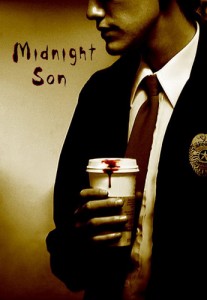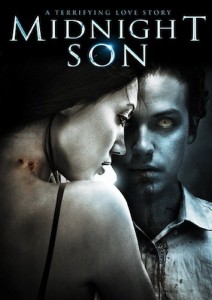Midnight Son is the story of Jacob, a young man confined to a life of isolation, due to a rare disorder that prevents him from being exposed to sunlight. His world opens up when he meets Mary, a local bartender, and falls in love. Tragically, Jacob’s actions become increasingly bizarre as he struggles to cope with the effects of his worsening condition. Forced by the disease to drink human blood for sustenance, he must control his increasingly violent tendencies as local law enforcement narrow their focus on him as a suspect in a series of grisly murders.
Writer/Director/Producer Scott Leberecht graduated from the University of Cincinnati College of Design, Architecture, Art and Planning in 1994. At age 24, Scott joined George Lucas’ Industrial Light & Magic Art Department.
When asked about the stark difference of Midnight Son when compared to films like Twilight, Scott says, “I believe most vampire films are the way they are because that specific romantic depiction is what sells, and it is very hard to get people to take a financial risk on something new. I guess I just wanted to tell a story about what happens when your body wants something your mind doesn’t. Anyone whose life gets turned upside down will initially see the event as debilitating and tragic,” he continues, “but it is not until you punch through the wall of denial that the skin of your old self can be shed, and ‘rebirth’ begins.”
“You have to be honest with me…Your body’s telling me you’re malnourished, but you say you’re eating like a horse. One of you is lying.” (Midnight Son)
Even within the context of this heightened reality, and the chaos that quickly exceeds the boundaries of what most can, or should, relate to, Midnight Son is a standout piece in the vampire genre; a glimpse of vampirism as biological and medical – rather than mysterious and sublime.

“I wanted Jacob to be someone we could relate to,” he says. “I wanted the rules he has to live by to be simple and biologically based. This narrowed it down to two major problems– sunlight and blood. I kept just enough mythology intact to call him a ‘vampire’ without falling into the trap of more spectacle-based aspects of the archetype. Being forced to stay out of sunlight and drink blood to survive felt like enough complication to me. These two things would create plenty of problems for any protagonist in a modern society.”
Read the full interview below, and be sure to check out Midnight Son on Netflix, Amazon DVD or Digital Download, and visit their official website.
How would you describe the central theme of Midnight Son?
I would say the central theme is acceptance. I believe everyone carries urges and thoughts that they feel are ‘wrong’ or even downright evil. For most people, these things are totally acceptable in our current culture, but sadly they have been conditioned to believe the worst. This can result in a very lonely existence fueled by a fear of rejection and even death. I have a personal theory that accepting our inner ‘monster’ is unavoidable if we are ever to achieve balance or what some might call happiness. All the characters in Midnight Son are fueled by an unconscious desire to accept themselves for what they truly are, or be accepted by those whom they love. Only one character– the villain, driven by ego– has no interest in either.
In a previous interview you said, “I realized I had never really seen a vampire film that depicted the physical condition as something debilitating and tragic, as opposed to empowering or romantic.” Why do you think that is?
I believe most vampire films are the way they are because that specific romantic depiction is what sells, and it is very hard to get people to take a financial risk on something new. I guess I just wanted to tell a story about what happens when your body wants something your mind doesn’t. The fact that this evolved into the story of a ‘reluctant blood drinker’ is not the result of a desire to stand out among others in the genre, or make something significant to the self-identified vampire community. I think after I started to see the movie in my mind, I realized that it had the potential to stand out. That was exciting to me as a filmmaker trying to compete in the marketplace, but it was never an intention from the beginning. Anyone whose life gets turned upside down will initially see the event as debilitating and tragic, but it is not until you punch through the wall of denial that the skin of your old self can be shed, and ‘rebirth’ begins.
What aspects of the vampire mythology and/or modern vampirism did you include in your story? As a vampire, “rules” does Jacob live by?
Jacob just has to do what he must to survive. He is very mortal, and has been thrown a new set of “rules” to cope with, as a mortal. I believe my unconscious goal was tomake the audience feel like they’ve been lied to all these years, and that being a vampire is, in reality, not glamorous or cool. I wanted Jacob to be someone we could relate to. I wanted the rules he has to live by to be simple and biologically based. This narrowed it down to two major problems– sunlight and blood. I kept just enough mythology intact to call him a ‘vampire’ without falling into the trap of more spectacle-based aspects of the archetype. Being forced to stay out of sunlight and drink blood to survive felt like enough complication to me. These two things would create plenty of problems for any protagonist in a modern society.
The theme of the first poster art seemed to be struggle, the second seems to be love. Do those two things have equal weight in your film? Is one more relevant to the story than the other?
They do have equal weight, and I think the reason is that I believe autonomy and intimacy go hand-in-hand. I have seen many friends lose their autonomy in a relationship, to the point that they cannot function without the other. Conversely, I have seen friends who lead an almost double life, behaving one way with their partner, and a completely different way when they are apart. I think there has to be a healthy balance between the two. This is the struggle I wanted for my characters.
What, or who, is your greatest inspiration as a filmmaker? What about it, or them, inspires you?
If I had one great inspiration as a filmmaker, it would probably be comic books. The root of understanding visual narrative began there.
Have you always been interested in making movies, or was your entrance into the profession something spontaneous?
I entered as a storyboard and concept artist for the visual effects industry. Making the leap into directing my own films was a challenge because up to that point I was simply a spatial artist. Composition, form, space, and color was what I had mastered. Some people think if you can make a pretty picture, you can direct a movie. I learned very quickly that art on the temporal level is very different– something I had no experience with. Musicians, playwrights, actors and comedians work with timing, performance, and rhythm the way a spatial artist works with color, line, space and form. They are two completely different creative disciplines that come together in one insanely powerful medium called film.
What advice would you give an aspiring screenwriter/director? What’s the best, or worst, advice someone ever gave you?
Make films because you have fun making films. Any other reason will result in heartbreak.
How would you describe your audience? Why should someone want to see Midnight Son?
People who enjoy a mature, sensitive story that also appeals to the monster-movie-loving kid inside us all will enjoy Midnight Son.
What excites you?
The internet has opened up a whole new way for filmmakers to exhibit their movies, find an audience and even make a little money. This definitely has me excited.
[Image Source: www.midnightsonmovie.com]

